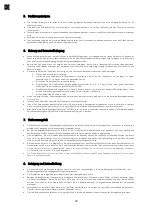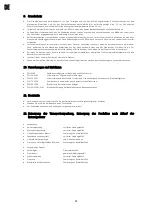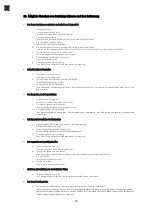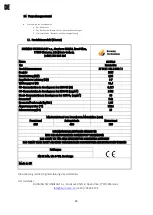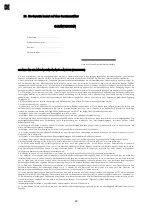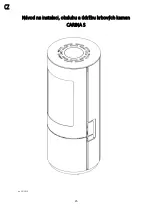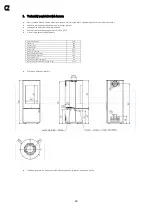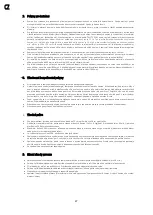
12
6.
Lighting Up and Stoking
If the stove was stored in a cold environment (car, store, etc.) before the first lighting, keep it at the room temperature for about
3 hours due to moisture condensation and surface temperature equalization of the parts before making the first lighting,
otherwise there is a risk of damage to the glass or lining of the stove.
During the first lighting, it is not possible to prevent the odour produced by the drying of the protective coating. The stove paint
will burn for at least 4 hours and it is therefore necessary to constantly ventilate and let fresh air into the room.
The rapid course of lighting is important, as there is an increase in emissions in the event of a poor technique.
a.
Open the air supply control completely.
b.
Place scrunched up newspaper or a firelighter in the centre of the fireplace, and put about 1 – 1,5 kg of finely chopped
wood crosswise over it.
c.
Ignite the fire and let it flame up.
d.
Then put 2 logs on the fire (approx. 1,4 – 1,6 kg). After they start burning well, reduce the combustion air supply to
25–30%.
e.
Once the fuel has burned out (the flame goes out – only embers remain), spread the embers evenly and open the air
supply completely.
f.
Repeat point d. and point e.
If too little wood is used during lighting or if the pieces of wood are too large, the optimal operating temperature will not be
reached. This can lead to poor combustion, high soot formation and extinguishing of the fire after closing the door.
Do not leave the stove unattended at the time of lighting.
If your house has mechanical ventilation system, or if an extractor hood is switched on, and there is low pressure inside, open the
window near the stove for a few minutes until the fire flames up.
For heating at a minimum output, reduce the combustion air supply to 20% (point d). Heat input at the minimum output is 4 kW
and the burning time is about 1,4 hrs.
7.
Combustion Air
The wood burning stove is dependent on ambient air, and the combustion air supply needs to be provided when taking the
combustion air from the room.
In case windows and doors are sealed, fresh air supply may not be ensured. This can affect the draught of the stove and it can
also unfavourably affect your sense of well-being or even your safety.
Vapour extractors located in the same room as the stove may adversely affect its function (smoke can escape into an occupied
room although the stove door is closed) and must therefore not be operated at the same time as the stove unless the air supply is
provided via an open window.
The stove has the possibility of supplying combustion air from the central air duct via a 99 mm diameter connection neck. The
connection neck is located at the bottom of the stove under the fireplace.
To ensure central air supply, the duct must not be
longer than 3 m and have too many bends. The minimum duct diameter is 80 mm.
The central air duct must be led outdoors or into a well-ventilated room inside the building (cellar, utility room, etc.).
8.
Fire Protection
The safe distance of flue pipes from the door frames and similarly placed building elements from flammable materials and from
piping installation including insulation is at least 20 cm. From other parts of elements made of flammable materials, it is at least
40 cm.
No flammable building elements and furniture may be located within 800 mm in the area of the glass door heat.
Apart from the heat area, minimal distances from flammable building elements and furniture are shown on the stove label and
must be observed.
In case of solid fuel stoves, the floor of flammable materials located in front of the stove door must be protected by a non-
flammable covering. This covering must extend 80 cm forward and 40 cm to the sides of the stove door.
In the event of a fire of soot in the chimney, extinguish the fire in the fireplace as soon as possible by means of a dry powder fire
extinguisher or, if necessary, sand, remove all flammable material from the vicinity of the stove and the chimney. Close the door,
the fireplace stove controls and the smoke control damper (if installed) and immediately report the fire to the fire brigade!
Do not leave the house until the chimney fire burns out, check the chimney temperature and the burning process continuously.
Never put out the fire in the fireplace with water!
If the wood burning stove is in use, the fireplace door must be closed to prevent flue gas from leaking.
9.
Cleaning and Inspection
The stove and flue pipes must be inspected once a year – or more frequently, for example when the chimney is cleaned – to
check for any soot and to clean them if needed.
The chimney needs to be cleaned regularly by a chimney sweeper.
Before the heating season, thoroughly clean the entire fireplace from ash and soot with a brush or a vacuum cleaner. Ensure that
ash fallen between the fireplace walls and the grate is removed and a small gap is left to allow the materials to dilate during long-
term use in the heating season.
Never use abrasive products to clean the glass or metal parts, as this may cause damage. The glass can only be cleaned if the
stove is cold.
The surface of the stove can be cleaned with a damp cloth or, if necessary, with a mild soap solution.
Содержание CARINA S
Страница 1: ...Instructions pour l installation service et maintenance des po les chemin e CARINA S 09 2018...
Страница 9: ...9 Instructions for Installation Use and Maintenance of a CARINA S Wood Burning Stove 09 2018...
Страница 17: ...17 Installations Bedienungs und Wartungsanleitung des Kaminofens CARINA S 09 2018...
Страница 25: ...25 N vod na instalaci obsluhu a dr bu krbov ch kamen CARINA S od 09 2018...




















